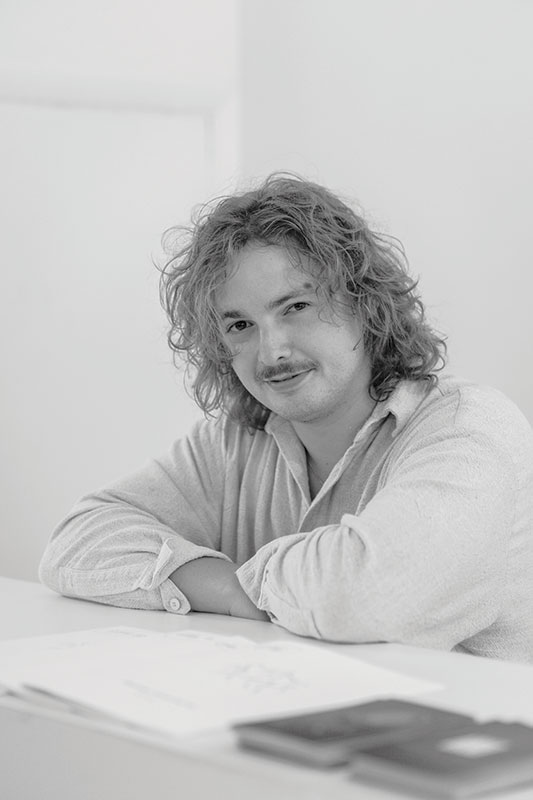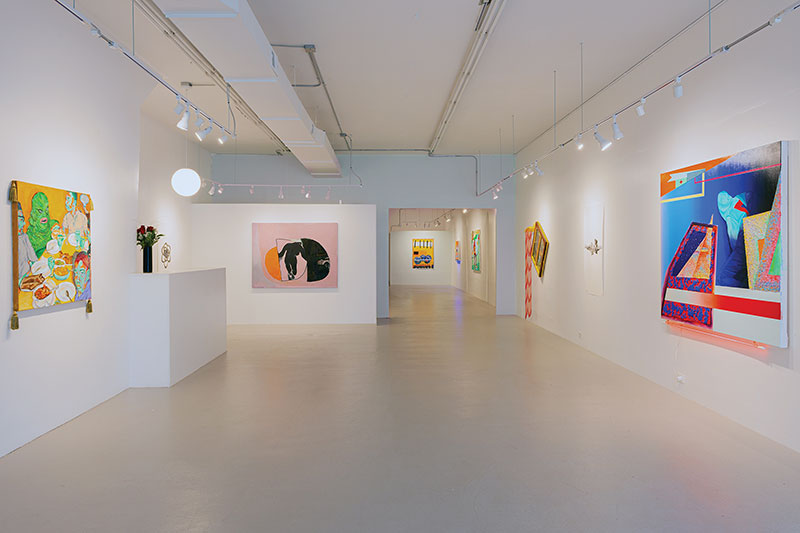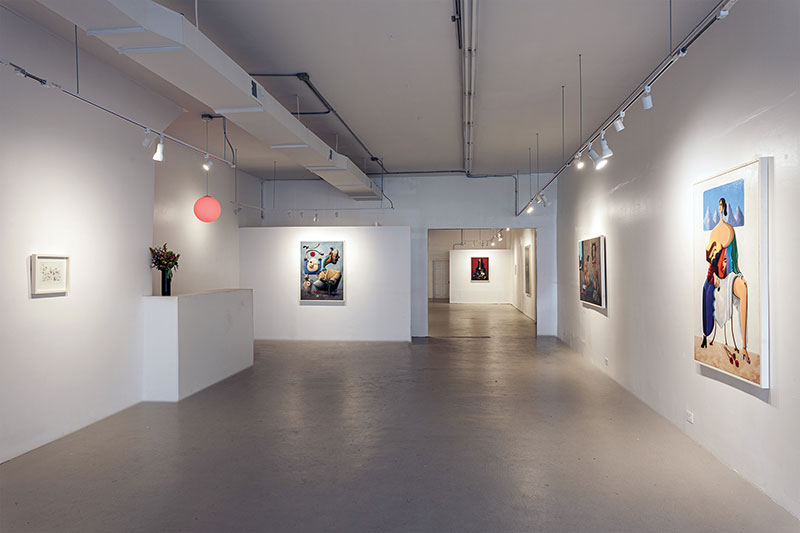A Young Gallerist Imagines the Future: Povos's Lucca Colombelli


By BIANCA BOVA
Lucca Colombelli speaks quickly, with a cavalier manner that suggests that even if he doesn’t—by his own admission—know what he’s doing, he certainly knows what it is that he is going to do next. On a recent visit to his gallery Povos’s Chicago Avenue location, which is currently under renovation, Colombelli walked me through the space while rattling off the forthcoming improvements to everything from the baseboards to the lighting. We then sat down for a conversation about the gallery’s simple beginnings, its rapid expansion, and the multi-hyphenate future Colombelli sees for himself as a young person in the art world.
CGN: Thank you for taking the time to speak with me, Lucca. Let’s begin with how your gallery, Povos, got its start.
Lucca Colombelli: I’m an artist first. I didn’t necessarily like the way that the [gallery] system was set up. I have been in those ‘rooms’ in the commercial art world and thought, ‘This doesn’t feel like it’s about art at all.’ I wanted to make [a space] that was beautiful and celebratory and inclusive.
CGN: What did you feel like the art world was about, if you didn’t feel like it was about art?
LC: To me the commercial art world [from galleries to art fairs], especially as an artist, felt very much like it was about money and about creating an exclusive culture that discouraged [most] people from getting involved, so [the main players] could maintain the power over both what’s being shown and where the money is moving. I try to convey [to my artists] that ‘this should be about you.’ That’s how I feel and I want them to feel too.
CGN: Even about art fairs? Which are inherently commercial spaces?
LC: it’s like the artist almost has no place at an art fair.
CGN: I like to say, “An art fair is no place for an artist.” Often it can feel like they’re the last person you want in the room when you’re doing a deal.
LC: The artist might not want to be there either. An artist I know, who is established, once said to me, ‘Going to the fair as an artist is like watching your parents have sex.’
Starting the gallery became this very difficult and involved learning process through which I can see how the system actually happens and can also work. EXPO CHICAGO this April will be my first fair [as a participating gallery]. With a seat at the table, what are we going to do with it? Who’s going to come and support it? How can we make it about the artist?
CGN: How, in practice, are you implementing that paradigm shift?
LC: I am not sure I can quantify how it’s working, but if you come to our gallery openings–there’s a good feeling. To me I think that’s largely because it’s been a grassroots gallery.
CGN: Is it still grassroots?
LC: This started as shows in an apartment, and then eventually shows on Milwaukee Avenue. It was a passion project. We were fortunate people came to support it and feel involved. There’s such a strong culture built around [Povos]. The people working here now, including me, are still practicing artists, but now we’re understanding how to do this. I’m bringing in a full time director, a manager and support staff. We have had a run of funding, and we’re opening a second location and doing the fairs. We’re also getting attention – from institutions, the press, and some major collectors. I’ve become friends with the heads of several national institutions and found mentors in the local art world as well.

CGN: You’re a young dealer, and you seem invested in pushing back against the art establishment, in creating your own model. The more transparent you can be the better, if you want others to be able to learn from what you’re doing.
LC: I didn’t know what the hell I was doing at all. I went to art school for two semesters and dropped out. The idea was to develop a sustainable online gallery model.
CGN: When you say sustainable, do you mean economically, ecologically, or in some other way?
LC: I’m talking about economics. Instead of 50/50 between the artist and the dealer, and putting a lot of money into real estate or rent, online it could be 70/30. A portion of that 30% would go to social work partners. I was interested in this idea of a low-overhead, online gallery that could also better the community. I worked with Chicago Social Change; Save Money, Save Life; and Simple Good, where I’m on the Associate Board. We did fundraisers, and I did a guest teaching spot last year. We’re looking at doing it again in the spring with after school programs.
So, initially the idea was to bring the digital to the physical as much as possible with popup events. We were doing it in restaurants, in houses, wherever. Then we got the space [on Chicago Avenue], and people started to notice us. A big advocate has been Abby Pucker [of Gertie]. She reached out in fall 2022, and we have become good friends. She’s helped elevate the project and put it on the map for new people. This went from an artist run project, to two locations, doing fairs and finding funding.
CGN: Can you share more about your funding model? Fairs don’t get cheaper year over year, and neither does real estate, for that matter.
LC: In year one, with the popup online model, I didn’t make any money. Year two, on Milwaukee Ave., going in we didn’t have even a year’s worth of overhead, let alone funds for staffing, events, and marketing. It was just me running it. It didn’t start going well until maybe August 2022, where we had a show with Will Schaeuble, a young SAIC graduate. We sold out opening night. We had never had anything like that happen.
CGN: What accounted for the difference?
LC: We started marketing [the show] really early. We seemed to do everything right. I thought, ‘Maybe this could work.’ Just a little earlier I thad hought, ‘Oh my God, how are we gonna pull this off?’ While there was a growing culture of artists hanging out, I didn’t think it was sustainable. I think this is a problem young galleries can face. You can approach it with a lot of passion, but it’s not necessarily going to make economic sense.
August happened and it worked. Then in September 2022 we sold out Ashkon Haidari’s opening night. After that I wanted to reorganize and to create new systems and bring in help. A big part of my philosophy has been: say yes, then figure it out. I saw the opportunity and the potential of [a physical] space, but when I got it it was a nightmare. It took a serious amount of work, but I knew we could turn this into something cool, and the price was right, even though I didn’t have the money until I did a little fundraising.
CGN: Was that primarily through private donations, or were you seeking grants?
LC: All private, mostly collectors who support my vision of this artist-utopic gallery.
CGN: Do any of the backers have equity in the gallery?
Yes, some of them have ownership stakes, but the majority are involved in a cultural or infrastructural way.
CGN: Do you intend to retain majority ownership long term?
LC: I’m more interested in building something sustainable and beautiful than maintaining my vision for it.
CGN: Do you feel that those are mutually exclusive?
LC: No, not necessarily. If someone wants to come in and do this or they have an idea for 10 locations, it can’t just be me making the calls on that. We’re building an advisory board and an internal board with the new equity members–local curators and multiple artists who I’ve contacted and who have said, “Yes, I’d love to be part of this.” It’s so rewarding to come from not knowing who any of these people were two years ago, to having my–I keep calling it, the Avengers Board.
CGN: Frankly, it’s uncommon to see that level of support being offered to someone who–as you put it yourself–knew no one and had no idea how the industry even worked just a year or two ago. What has helped you most in establishing that base of support?
LC: I think it has a lot to do with the feeling of the space and our philosophy. It’s not about closing the door or opening it selectively. It’s about, “Hey, we got the foot in the door. Everybody come check this out.”

CGN: Do you feel that that’s an ethos that makes you distinct from other galleries in the city?
LC: I know there are a lot of really inclusive, cool people in Chicago. It’s easy to be a young artist and think, “Oh, I don’t want to work with them,” or “Screw the man!” It’s an immature attitude that I had, and now I realize that all these people are very smart and great and also work in some similar ways.
CGN: Who are other dealers that you admire?
LC: Mariane Ibrahim–I think she’s a rock star. I also really like Patron’s program, and they’re very friendly to us as well. You could throw a rock and hit a good gallery on this street.
CGN: Can you tell me more about what informs Povos’ program?
LC: To begin with it was just people I liked. We’re evolving towards the space being spearheaded by smart and interesting collaborations with other people, not necessarily just my vision.
CGN: Do you represent artists? Do you have a stable?
LC: We don’t currently represent people exclusively. I never thought I had enough to offer. But now we’re going to try to sign people locally for representation, about eight artists.
CGN: Can you tell me about the gallery’s second location?
LC: Last year I exhibited my paintings with Winston Guo, who ran W. Gallery in the South Loop on Van Buren. I haven’t shown in years and never really in Chicago. We threw a big opening. It was really fun, we sold some work. Winston and I talked about our gallery practices and differing strengths and challenges. This year he will come on as a full time director with me, primarily based out of his original space. We’re calling it “Povos Downtown.”
CGN: Do you plan on running two simultaneous programs, or will it serve as an extension space?
LC: It’ll be staggered. So yes to two programs, five shows each a year, for one year.
CGN: What is happening in the meantime?
LC: We’ve stepped into an advisory network of secondary market dealers who are also young and ambitious. I’m doing some interesting work with 20th century art. I also met a guy in Mexico and we’re considering forming an international advisory with a Latin American and Italian masters focus. That’s not technically Povos, but that’s me. Also, I’m possibly curating a museum show in Japan this year at the Kyoto City Art Museum.
CGN: Is the Kyoto City Art Museum an institution you have an existing relationship with? How did that opportunity come about?
LC: There’s an arts government program in Kyoto. You take corporate tax money and turn it into something art related. The companies get a write-off, and the city gets a cut. A friend from art school has a connection to one of these programs, and that brought about the opportunity.
I hope I can do a lot more for artists and in this industry if I can fulfill every role. I can be a curator, I could be an advisor, I could be a gallery, I could be an institution. If we have all the moving parts, we can accomplish a lot.
CGN: What do you see as the advantage to that approach over selecting a role, and devoting yourself to it?
LC: I think you don’t have to be at the mercy of a system when you can fulfill multiple roles within it, and create new systems with that.
CGN: Do you ever worry that could potentially be a disservice to your artists? That if you’re successful in creating these new systems, you risk divorcing them from the conventional art world at an early stage?
LC: No, I don’t think we’re divorcing them from the system at all. We just are becoming more involved in the system. Instead of just fulfilling the role of the gallery, we can go and make other kinds of deals and opportunities for them.
CGN: There’s a rich history in Chicago of artist-run spaces that have gone on to achieve great commercial success. Take for example, many of the galleries that have participated in both editions of the Hyde Park Art Center’s Artists Run Chicago exhibitions, or going back even further, the spaces profiled in the the Museum of Contemporary Art, Chicago’s 1984 catalog Alternative Spaces: A History in Chicago. I’m hearing that you feel you’re subverting that standard developmental model, and that you’re successfully breaking boundaries. I’m trying to parse out what it is that makes you and your gallery different. Can you help articulate that for me?
LC: I think keeping this glass door policy with the people we work with is different. Also our local cultural presence is a big thing, because it is inclusive.
CGN: You acknowledged earlier that many Chicago galleries’ cultures are inclusive, so what sets Povos apart?
LC: It’s the only space where I’ve seen the interaction between the billionaire and the bartender. Everyone walks in here and no one knows who anyone is, but they’re there and “Hey, what’s up?” is a very approved action at Povos.
CGN: Programmatically, where do you feel that your gallery fits into the context of Chicago?
LC: I think we have a unique vision, which is the artists that I think we represent locally largely are, I call it, folkloric surrealism. It is an ongoing theme, and I think that’s what I enjoy. Some artists are self-taught, some are trained. All of our artists are young and working in this kind of magical way.
CGN: Chicago has deep historical associations with certain movements in the art world, and you can see the legacies of those movements in contemporary galleries’ programs today. I’m curious where you see Povos’ program in that context, if at all?
LC: I never thought about it much. I am kind of new, and even new to the [art] scene. I’ve been [in Chicago] about seven years, and it has been a learning process. As far as historically, I don’t know if I’m informed enough to place the gallery anywhere. I think right now, it feels like we’re the new generation.
CGN: What brought you to Chicago, and what made you want to stay?
LC: Yes, I spent two semesters at SAIC, where I met some of my best friends. I had a really good professor who said “You seem like you know what you want to do. You want to go paint, go paint. You want to open a gallery? Open a gallery. You don’t have to be here to do that.” And he was right, ultimately.
I’m grateful to Chicago for letting me get away with this. I don’t think I would have been able to do it anywhere else. Buckle up, and let’s see what happens with the real version of this, because I think it hasn’t realized its full potential. I’m excited to see where it goes.
#
This interview is featured in the spring/summer 2024 issue of CGN. To subscribe to the print edition click here.






